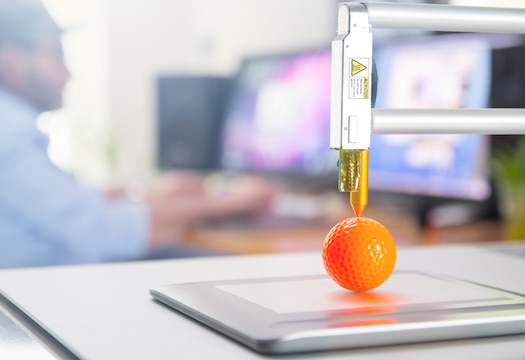 3D printers have revolutionized research and development. Where it used to take weeks to get a prototype built for testing, now one can be printed in hours. New and innovative uses for 3D printers keep popping up in more and more industries – from food, to homes, and even prosthetic limbs. Additionally, 3D printers are becoming steadily more affordable and portable. However, for producers of potentially (and / or intentionally) 3-D printed goods, the question of how to protect their innovations rises front and center.
3D printers have revolutionized research and development. Where it used to take weeks to get a prototype built for testing, now one can be printed in hours. New and innovative uses for 3D printers keep popping up in more and more industries – from food, to homes, and even prosthetic limbs. Additionally, 3D printers are becoming steadily more affordable and portable. However, for producers of potentially (and / or intentionally) 3-D printed goods, the question of how to protect their innovations rises front and center.
Innovators often face the question of how to best protect their new ideas. Patents immediately come to mind for new products and processes. However, copyright protection should also be considered. While patent protection is limited to the claims in a particular patent, copyright protection can be broader, particularly where 3D works of art are concerned. Additionally, copyright protection may provide some protection where a 3D rendering is made of a known 2D work.
Of course, not every 3D printed item will be eligible for protection. Copyright eligible subject matter is laid out in 17 U.S.C. § 102. For example, copyrightable subject matter likely does not exist for a 3D printed version of a common object – like a 3D printed fork and spoon. Copyright protection is expressly reserved to aesthetically separable portions of a work, and does not extend to a work’s functional features. Therefore, 3D printing a fork and spoon with intricate, and original, scrollwork may be eligible for copyright protection.
Additionally, if an original, non-3D printed object is copyright eligible, the copyright owner may have recourse against those 3D printing copies. Copyright law also grants copyright owners the exclusive right to make derivative works – so long as the translation to a 3D printed object constitutes “an original work of authorship.”
So, while 3D printed objects may be eligible for copyright protect, a registered copyright is only as valuable as it is enforceable. 17 U.S.C. § 501 defines a copyright infringer as anyone “who violates any of the exclusive rights of the copyright owner.”
The manufacturers of 3D printers make the technology to use 3D models, for example from Thingiverse, to make 3D printed objects. However, the manufacturers themselves are not likely infringing any copyrights or patents on 3D printed products or processes. Additionally, many users of 3D printers are making products for personal use, and are therefore difficult to detect.
However, websites aggregating Computer-Aided Design (CAD) files for download and use in personal 3D printers may be liable for making copyrighted designs available for download (copying) by users of 3d printers. Copyright owners can use the procedures outlined by the Digital Millennium Copyright Act (DMCA) to have infringing files removed – for example by filing take-down notices. One of the first copyright complaints regarding 3D printing concerned the “Penrose Triangle” optical illusion, which was first printed by Ulrich Schwanich. It was later uploaded to Thingiverse by a different individual. Schwanich filed a DMCA take-down request, and the first official 3D printing copyright dispute was born. While it was not ruled on by a court (Schwanich encountered a significant public outcry and withdrew the complaint).
While the legal understanding is catching up to the possibilities of 3D printing, some manufacturers are taking additional steps to protect, or at least authenticate, their 3D printed goods from others. For example, a 3D model can be encrypted so that it is difficult to copy, and different anti-scamming technologies, such as use of reflective coatings, can make it difficult to easily copy a 3D printed design. Unfortunately, the encryptions available may deter recreational 3D printers, but likely will not be enough to hold off serious infringers. And, while reflective coatings make it difficult to image a 3D design, a layer of dulling spray paint will fix that.
Thinking about protecting 3D printable goods using legal means other than patents illustrates the parallels between 3D printing and other industries that rely heavily on copyright, and trademark, protection. For example, luxury fashion and accessories have dealt with rampant low-quality copies flooding the market for years. Approaching the problem of 3D printing with the mindset of “authentic” verse “counterfeit” goods suggests some different technological solutions.
Counterfeiters in any industry can often act quickly to obtain, copy, and produce mock versions of goods. 3D printing offers a similar option to make counterfeits get to market quickly. Once counterfeit goods get to market they can cause significant brand damage related to quality differences, and create customer confusion. For this reason, luxury brands often seek to stop the counterfeiting either at its source, keep goods from entering the country at all, or ensuring that customers can clearly identify the original from the fake.
However, when the original 3D model is kept secret by the original creator, different authentication options are available. For example, the fashion industry is known for using invisible patterns that are only visible under special lighting – an easy check for customs agents at the border.
Authentication for 3D printed, or printable objects can include embedding QR codes, barcodes, or other microstructures on the surface. If the source code for the 3D model is not available, counterfeiters are limited to what can be imaged from the product. If the microstructures cannot be accurately imaged, they will not be included as part of the copy. However, the mechanism for authentication will need to be recognizable by Customs agents at the border, by an intermediate seller, or by the customer themselves.
Copyright protection can often be obtained faster than patent protection, last much longer, and is obtainable at a lower cost. Additionally, copyright damages are statutory, whereas patent infringement damages must be separately proven at trial. While the protection is different, if a product infringed by 3D printing would meet the substantially similar standard (e.g. downloading and using the same CAD file), copyright protection may be a necessary way to protect 3D printable innovations in the future.
Images Source: Deposit Photos.

![[IPWatchdog Logo]](https://ipwatchdog.com/wp-content/themes/IPWatchdog%20-%202023/assets/images/temp/logo-small@2x.png)

![[Advertisement]](https://ipwatchdog.com/wp-content/uploads/2024/04/UnitedLex-May-2-2024-sidebar-700x500-1.jpg)
![[Advertisement]](https://ipwatchdog.com/wp-content/uploads/2024/04/Patent-Litigation-Masters-2024-sidebar-700x500-1.jpg)

![[Advertisement]](https://ipwatchdog.com/wp-content/uploads/2021/12/WEBINAR-336-x-280-px.png)
![[Advertisement]](https://ipwatchdog.com/wp-content/uploads/2021/12/2021-Patent-Practice-on-Demand-recorded-Feb-2021-336-x-280.jpg)
![[Advertisement]](https://ipwatchdog.com/wp-content/uploads/2021/12/Ad-4-The-Invent-Patent-System™.png)






Join the Discussion
One comment so far.
Bruce Hannah
August 16, 2018 06:04 pmNice article….interesting thoughts on how copyright can quickly protect ideas. Also important is preserving early sketches and correspondence relating to the ideas embodied in the design